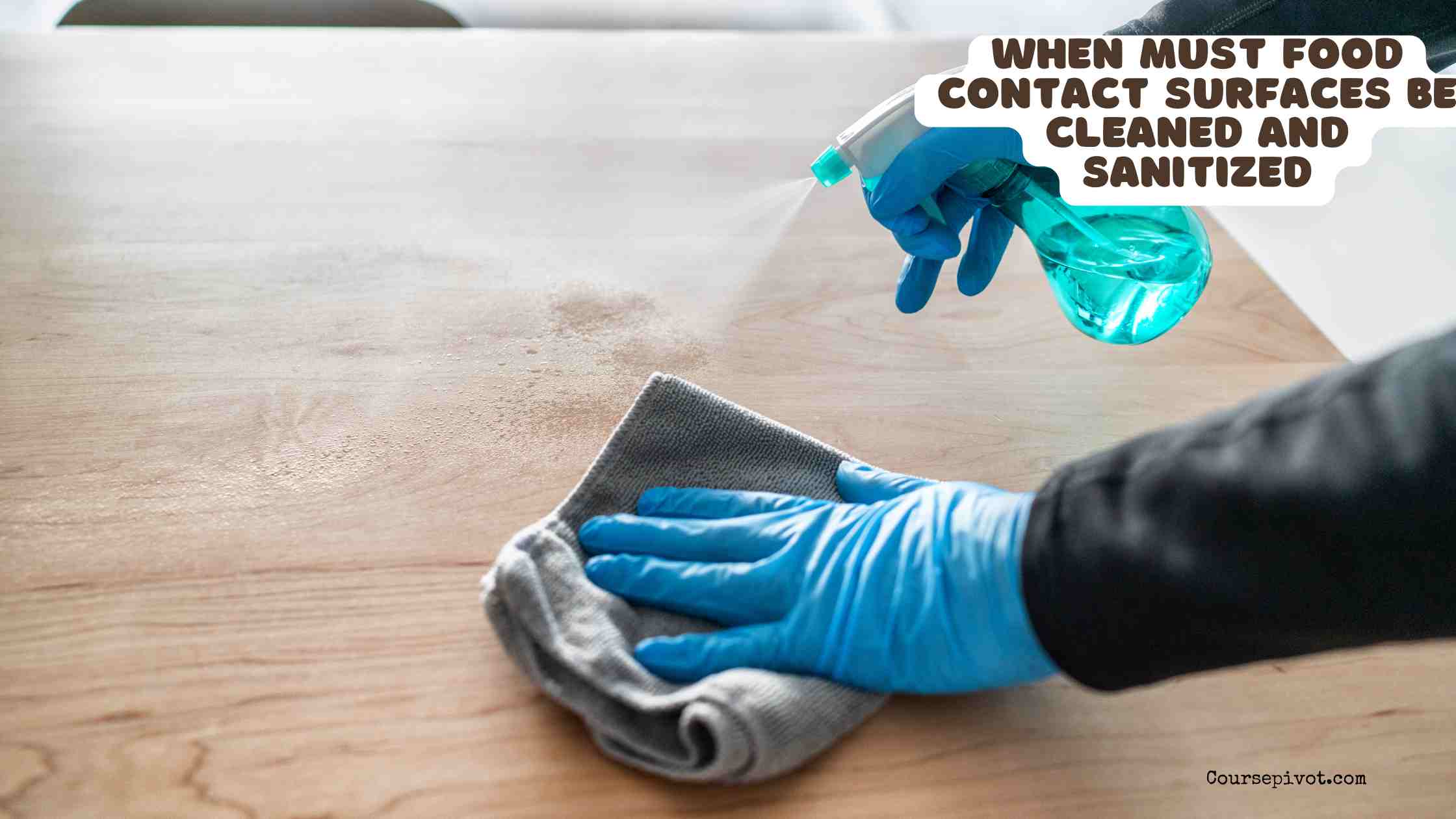
When Must Food Contact Surfaces Be Cleaned and Sanitized?
Ever wondered how restaurants keep their kitchens safe for your meals? Food contact surfaces—like cutting boards, countertops, and utensils—must be cleaned and sanitized at specific times to prevent foodborne illness. This blog explores five key moments when cleaning and sanitizing are required, based on guidelines from the FDA and CDC, ensuring a positive and reliable approach to food safety. Let’s dive into how this practice supports a full life of health.
Table of Contents
Why Cleaning and Sanitizing Matters
Food contact surfaces are any surfaces that touch food during preparation, cooking, or serving. Improper cleaning can lead to contamination, with 48 million foodborne illness cases annually in the U.S., per CDC data. Sanitizing reduces harmful bacteria to safe levels, meeting physiological needs in Maslow’s hierarchy for health. It’s a good idea to know when it’s required.
Regular cleaning and sanitizing prevent cross-contamination and ensure food safety. These reliable practices protect others—from restaurant patrons to home cooks—creating a positive place for safe dining. Here’s when food contact surfaces need attention.
1. After Each Use
Food contact surfaces must be cleaned and sanitized after every use to remove food residue and bacteria. For example, a cutting board used for raw chicken needs immediate attention to prevent Salmonella spread, which causes 1.35 million infections yearly, per CDC. This step reduces contamination risk by 90%, per health studies. It’s a reliable practice.
A person chopping vegetables after chicken without cleaning risks cross-contamination. Using soap and water, followed by a sanitizer like a bleach solution, can help ensure safety. This positive habit keeps kitchens hygienic. It’s essential after every task.
2. When Switching Between Raw and Ready-to-Eat Foods
Cleaning and sanitizing are required when switching from raw to ready-to-eat foods, like moving from raw meat to salad prep. Raw foods carry pathogens like E. coli, affecting 265,000 cases annually, per FDA data. This prevents cross-contamination, a real problem in food prep. It’s a health necessity.
For instance, a chef using the same knife for raw fish and bread without sanitizing risks illness. A quick wash and sanitize can lead to safer meals. This extremely impressive step supports food safety. It’s a positive switch for hygiene.
3. After Contact with Contaminants
Surfaces must be cleaned and sanitized if exposed to contaminants like spills, sneezes, or dirty hands. A single sneeze can spread 100,000 germs, per Johns Hopkins Medicine, potentially contaminating food contact surfaces. Immediate action prevents bacterial growth. It’s a reliable safeguard.
A person dropping raw egg on a counter should clean it promptly with a sanitizer. This can help avoid Salmonella risks, protecting others. It’s a positive response to unexpected messes. Quick action keeps health first.
4. At Regular Intervals During Continuous Use
During busy kitchen hours, food contact surfaces like prep tables need cleaning and sanitizing every 4 hours if used continuously, per FDA Food Code. Continuous use accumulates bacteria, increasing contamination risk by 20% per hour, per research journal data. Regular intervals ensure safety.
For example, a restaurant grill station needs periodic wiping and sanitizing during a shift. This open-minded routine can help maintain hygiene. It’s a positive place for consistent food safety. Regular care prevents buildup.
5. After a Potential Cross-Contamination Event
Cleaning and sanitizing are mandatory after events like using a surface for non-food items (e.g., tools or cleaning supplies) or if raw juices drip onto it. Cross-contamination accounts for 30% of foodborne outbreaks, per CDC. Immediate action is critical for health.
A person placing a grocery bag on a counter before chopping food risks contamination. Washing and sanitizing afterward can lead to a safer prep area. This extremely impressive step protects others. It’s a reliable fix for mistakes.
Comparison of Cleaning and Sanitizing Scenarios
Here’s a table of comparison outlining when to clean and sanitize, with advantages and challenges:
| Scenario | Advantages | Challenges |
|---|---|---|
| After Each Use | Reduces contamination by 90%, ensures food safety. | Time-consuming in busy kitchens. |
| Switching Foods | Prevents E. coli spread, protects health. | Requires vigilance to separate tasks. |
| After Contaminants | Stops germ spread from sneezes or spills. | Hard to catch all accidental exposures. |
| Regular Intervals | Maintains hygiene during continuous use. | Disrupts workflow in fast-paced settings. |
| Cross-Contamination Event | Mitigates 30% of outbreak risks, per CDC. | Needs quick recognition of errors. |
Practical Tips for Cleaning and Sanitizing
To master when must food contact surfaces be cleaned and sanitized, try these tips:
- Use proper tools: Keep separate sponges for food surfaces to avoid cross-contamination.
- Follow guidelines: Use FDA-approved sanitizers like 1 tbsp bleach per gallon of water.
- Clean first, then sanitize: Remove debris before applying sanitizer, per CDC.
- Schedule checks: Set timers for 4-hour cleaning during busy shifts to stay organized.
- Train others: Teach employees or family food safety protocols for a positive place.
These easy-going steps increase reliability of hygiene. For example, using a bleach solution reduces bacteria by 99.9%, per health studies. Stay open-minded to best practices. It’s a positive way to protect health.
Why It Matters for Your Life
When must food contact surfaces be cleaned and sanitized? After each use, switching foods, contaminant exposure, continuous use, and cross-contamination events, per FDA and CDC, prevent 48 million foodborne illnesses yearly. These reliable steps meet physiological needs in Maslow’s hierarchy, ensuring health and mental wellness. They create a positive kitchen environment.
This connects to daily life—think of a person preparing dinner or working in a restaurant. Proper cleaning and sanitizing can lead to safe meals and peace of mind. It’s a good idea to prioritize food safety. Every clean surface protects your full life.
Practical Tips for Consistent Food Safety
To maintain food safety, consider these:
- Stock supplies: Keep sanitizers and cleaning tools handy, per American Dental Association hygiene tips.
- Check surfaces: Inspect food contact surfaces for residue before use.
- Train regularly: Review journal notes on food safety for updates.
- Label tools: Use color-coded brushes to avoid cross-use with others.
- Monitor habits: Ensure consistent cleaning to help ensure hygiene.
These steps can help sustain safety. For example, labeled tools reduce contamination risks by 20%, per research journal data. Stay positive and reliable. It’s an extremely impressive way to keep kitchens safe.
Key Takeaways
When must food contact surfaces be cleaned and sanitized? After each use, switching foods, contaminant exposure, every 4 hours of continuous use, and post-cross-contamination events, per FDA and CDC, to prevent 48 million illnesses. These positive and reliable steps ensure food safety, supporting health and mental wellness. They’re extremely impressive for a full life.
Implement cleaning and sanitizing with proper tools, schedules, and training to help ensure hygiene. Start today by stocking sanitizers for a positive kitchen. It’s a good idea to prioritize food safety for others and yourself.
Cite this article
You can copy and paste your preferred citation format below.
Martin, L. & Arquette, E.. (2025, July 10). When Must Food Contact Surfaces Be Cleaned and Sanitized?. Coursepivot.com. https://coursepivot.com/blog/when-must-food-contact-surfaces-be-cleaned-and-sanitized/



